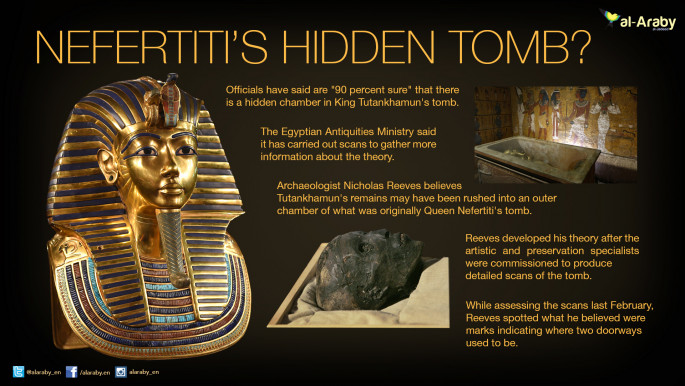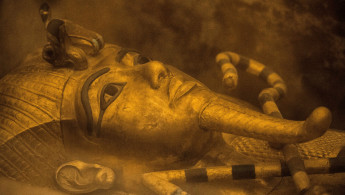Egyptologists '90% sure' of hidden chamber in Tut's tomb
Egyptian officials now say they are "90 percent sure" that there is a hidden chamber secreted deep within the tomb of King Tutankhamun's.
3 min read
Experts are "approximately 90 percent" sure there is a hidden chamber in Tut's tomb [Getty]
Scans of King Tutankhamun's tomb in Egypt's Valley of the Kings point to a secret chamber, archaeologists said this weekend, possibly heralding the discovery of Queen Nefertiti's long-sought mummy.
Using hi-tech infrared and radar technology, researchers are trying to unravel the mystery over the legendary monarch's resting place.
A wife of Tutankhamun's father Akhenaten, Nefertiti played a major political and religious role in the 14th century BC, and the discovery of her tomb would be a major prize for Egyptologists.
Experts are now "approximately 90 percent" sure there is a hidden chamber in Tutankhamun's tomb, Antiquities Minister Mamduh al-Damati told a news conference.
The scans were spurred by a study by renowned British archaeologist Nicholas Reeves that said Nefertiti's lost tomb may be hidden in an adjoining chamber.
Speaking at the same press conference, Reeves said the initial results could bear out his theory.
"Clearly it does look from the radar evidence as if the tomb continues, as I have predicted," he said.
"The radar, behind the north wall seems pretty clear. If I am right it is a continuation - corridor continuation - of the tomb, which will end in another burial chamber," he said.
"It does look indeed as if the tomb of Tutankhamun is a corridor tomb and it continues beyond the decorated burial chamber," he added.
"I think it is Nefertiti and all the evidence points in that direction."
Damati emphasised that the findings were "preliminary" results, and a Japanese expert working with the archaeologists needed a month to analyse the scans.
Experts carried out a preliminary scan of the tomb earlier this month using infra-red thermography to map out the temperature of its walls.
Damati said at that time that the analysis showed "differences in the temperatures registered on different parts of the northern wall" of the tomb.
But the minister and Reeves had differed on whose mummy they expected to find.
According to Reeves, professor of archaeology at the University of Arizona, Tutankhamun, who died unexpectedly, was buried hurriedly in an underground chamber probably not intended for him.
The boy king died aged 19 in 1324 BC after just nine years on the throne. His final resting place was discovered by another British Egyptologist, Howard Carter, in 1922.
Reeves' theory is that priests would have been forced to reopen Nefertiti's tomb ten years after her death because the young pharaoh's own mausoleum had not yet been built.
But Damati believes that such a chamber, if found adjoining Tutankhamun's tomb, may contain Kiya, another of Akhenaten's wives.
Akhenaten is known for having possibly temporarily converted ancient Egypt to monotheism by imposing the cult of sun god Aton.
Nefertiti's role in the cult would have ruled out her burial in the Valley of the Kings according to Zahi Hawass, the country's former antiquities minister and expert on ancient Egypt.
"Nefertiti will never be buried in the Valley of the Kings," he said.
"The lady was worshipping Aton with Akhenaten for years. The priests would never allow her to be buried in the Valley of the Kings," he said.
Hawass also questioned how archaeologists would enter the hidden part of the tomb without causing damage.
Damati said that after the analysis, that would be the next challenge.
"The data is being analysed to get a clear picture of what's behind the wall," he said.
"The next step, which we will announce once we agree on it, will be accessing what's behind the wall without damaging the tomb," he said.
Using hi-tech infrared and radar technology, researchers are trying to unravel the mystery over the legendary monarch's resting place.
A wife of Tutankhamun's father Akhenaten, Nefertiti played a major political and religious role in the 14th century BC, and the discovery of her tomb would be a major prize for Egyptologists.
 |
|
| Reeves (L) has said Nefertiti's tomb may be hidden in Tut's [Getty] |
The scans were spurred by a study by renowned British archaeologist Nicholas Reeves that said Nefertiti's lost tomb may be hidden in an adjoining chamber.
Speaking at the same press conference, Reeves said the initial results could bear out his theory.
"Clearly it does look from the radar evidence as if the tomb continues, as I have predicted," he said.
"The radar, behind the north wall seems pretty clear. If I am right it is a continuation - corridor continuation - of the tomb, which will end in another burial chamber," he said.
"It does look indeed as if the tomb of Tutankhamun is a corridor tomb and it continues beyond the decorated burial chamber," he added.
"I think it is Nefertiti and all the evidence points in that direction."
 |
|
| [Click to enlarge] |
Damati emphasised that the findings were "preliminary" results, and a Japanese expert working with the archaeologists needed a month to analyse the scans.
Experts carried out a preliminary scan of the tomb earlier this month using infra-red thermography to map out the temperature of its walls.
Damati said at that time that the analysis showed "differences in the temperatures registered on different parts of the northern wall" of the tomb.
But the minister and Reeves had differed on whose mummy they expected to find.
According to Reeves, professor of archaeology at the University of Arizona, Tutankhamun, who died unexpectedly, was buried hurriedly in an underground chamber probably not intended for him.
The boy king died aged 19 in 1324 BC after just nine years on the throne. His final resting place was discovered by another British Egyptologist, Howard Carter, in 1922.
Reeves' theory is that priests would have been forced to reopen Nefertiti's tomb ten years after her death because the young pharaoh's own mausoleum had not yet been built.
But Damati believes that such a chamber, if found adjoining Tutankhamun's tomb, may contain Kiya, another of Akhenaten's wives.
Akhenaten is known for having possibly temporarily converted ancient Egypt to monotheism by imposing the cult of sun god Aton.
Nefertiti's role in the cult would have ruled out her burial in the Valley of the Kings according to Zahi Hawass, the country's former antiquities minister and expert on ancient Egypt.
"Nefertiti will never be buried in the Valley of the Kings," he said.
"The lady was worshipping Aton with Akhenaten for years. The priests would never allow her to be buried in the Valley of the Kings," he said.
Hawass also questioned how archaeologists would enter the hidden part of the tomb without causing damage.
Damati said that after the analysis, that would be the next challenge.
"The data is being analysed to get a clear picture of what's behind the wall," he said.
"The next step, which we will announce once we agree on it, will be accessing what's behind the wall without damaging the tomb," he said.





 Follow the Middle East's top stories in English at The New Arab on Google News
Follow the Middle East's top stories in English at The New Arab on Google News
![The UAE is widely suspected of arming the RSF militia [Getty]](/sites/default/files/styles/image_330x185/public/2024-11/GettyImages-472529908.jpg?h=69f2b9d0&itok=Yauw3YTG)
![Netanyahu furiously denounced the ICC [Getty]](/sites/default/files/styles/image_330x185/public/2024-11/GettyImages-2169352575.jpg?h=199d8c1f&itok=-vRiruf5)
![Both Hamas and the Palestinian Authority welcomed the ICC arrest warrants [Getty]](/sites/default/files/styles/image_330x185/public/2024-11/GettyImages-2178351173.jpg?h=199d8c1f&itok=TV858iVg)